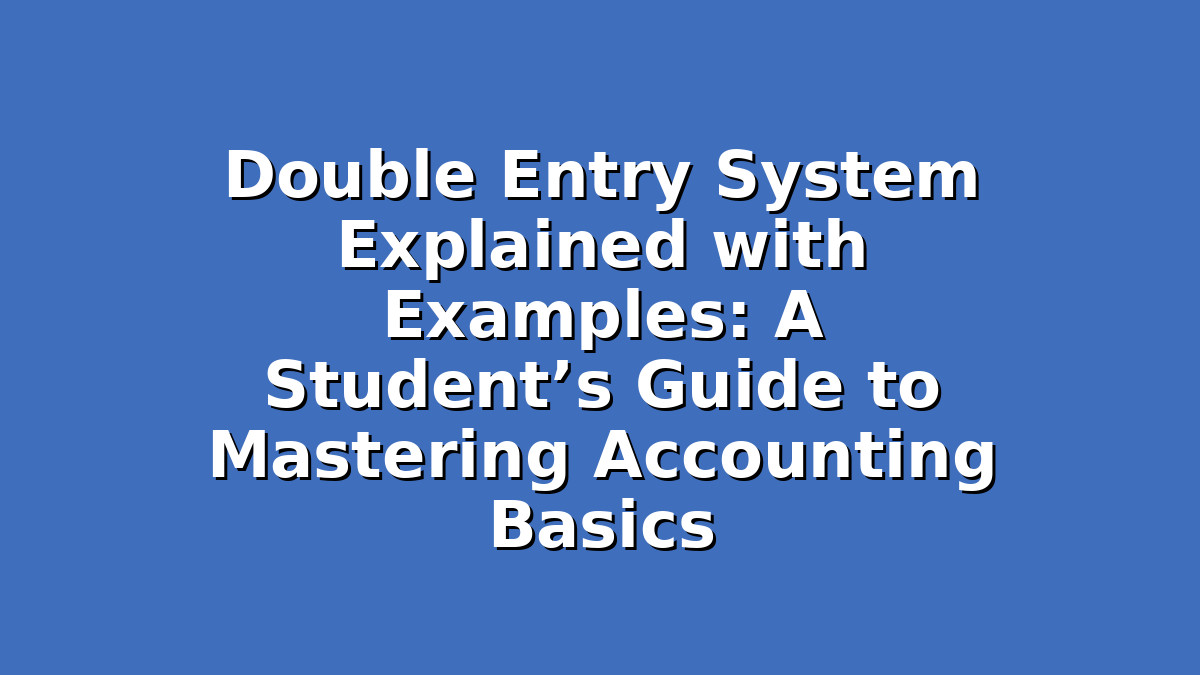If you’re a student preparing for exams in accounting or just looking to strengthen your understanding of fundamental concepts, the double entry system is a topic you absolutely need to master. It forms the backbone of modern accounting and is crucial for maintaining accurate financial records. While it might seem complex at first, with the right approach and examples, you can easily grasp how it works and apply it confidently in your studies and exams.
In this blog post, we’ll break down the double entry system in a simple and clear way, provide practical examples, and share study tips that will help you remember and understand the concept better. Let’s dive in!
What is the Double Entry System?
At its core, the double entry system is an accounting method that records every financial transaction twice – once as a debit and once as a credit – ensuring the accounting equation (Assets = Liabilities + Equity) stays balanced. This dual recording helps in tracking where money is coming from and where it is going, reducing errors and providing a complete picture of an organization’s financial health.
Why is this important for students?
Understanding this system is essential because it forms the basis for preparing financial statements such as the balance sheet and income statement. It also teaches you the logic behind financial transactions, which is helpful not just for exams but for real-world applications in business and finance.
Section 1: The Basics of Debit and Credit – Study Tips to Remember Them
Before jumping into examples, you need to get comfortable with the terms *debit* and *credit*. These are the building blocks of the double entry system and can sometimes be confusing.
– Debit (Dr) generally means an increase in assets or expenses or a decrease in liabilities or equity.
– Credit (Cr) generally means an increase in liabilities, equity, or income, or a decrease in assets or expenses.
Study tip: Use mnemonics to memorize these rules. One popular one is DEAD CLIC:
– DEAD = Debit increases Expenses, Assets, and Drawings.
– CLIC = Credit increases Liabilities, Income, and Capital.
Also, practice drawing simple T-accounts, which look like the letter “T”. Write Debit on the left side and Credit on the right. This visual tool helps you understand how each transaction affects different accounts.
Example: Suppose you buy stationery for cash worth $50.
– Debit Stationery Expense $50 (because expenses increase)
– Credit Cash $50 (because asset cash decreases)
Try writing this out in a T-account format to reinforce the learning.
Section 2: How Does the Double Entry System Work? Step-by-Step Examples
Let’s look at some clear examples of financial transactions to see how the double entry system works in practice. Every transaction impacts at least two accounts, keeping the books balanced.
Example 1: Owner invests cash into the business
– Owner invests $1,000 cash into the business.
– Debit Cash $1,000 (Asset increases)
– Credit Capital $1,000 (Owner’s equity increases)
This shows that the business now has more cash, and the owner’s stake in the business also increases by the same amount.
Example 2: Buying equipment on credit
– Purchase equipment costing $500 on credit.
– Debit Equipment $500 (Asset increases)
– Credit Accounts Payable $500 (Liability increases)
Here, you recognize the equipment asset but also record the liability since it hasn’t been paid yet.
Example 3: Paying off a liability
– Pay $300 of the accounts payable in cash.
– Debit Accounts Payable $300 (Liability decreases)
– Credit Cash $300 (Asset decreases)
By practicing these examples, you’ll see the pattern that every debit entry has a corresponding credit entry. This reinforces the principle of balance and completeness in accounting records.
Study tip: Create flashcards with different transaction scenarios on one side and the correct double entry on the other. Regular self-testing will boost your confidence and recall during exams.
Section 3: Applying the Double Entry System in Your Exam Preparation
When preparing for exams, understanding the concepts is half the battle; applying them effectively is the other half. Here are some tips to help you excel:
1. Understand the accounting equation: Know how assets, liabilities, and equity interact. Every transaction will impact at least two of these elements. Visualize the equation changes for each transaction.
2. Practice makes perfect: Solve as many practice questions as possible. Many textbooks and online resources offer exercises specifically on the double entry system. The more you practice, the more intuitive it becomes.
3. Use diagrams and mind maps: Visual aids can help you organize information about account types, normal balances (debit or credit), and transaction effects. This method is especially useful before exams to quickly revise.
4. Relate to real-life examples: Connect textbook concepts to everyday situations, like buying snacks (expense), receiving pocket money (income), or borrowing from friends (liability). This contextual understanding makes the system less abstract.
5. Review common pitfalls: Make note of frequent errors such as mixing up debit and credit or forgetting to record both sides of a transaction. Awareness of these mistakes helps you avoid them.
6. Study in groups: Discussing transactions and double entry concepts with peers can provide new insights and reinforce your understanding. Teaching others is also one of the best ways to learn.
Conclusion
Mastering the double entry system is an essential step for any student studying accounting or finance. Although it might seem challenging at first, breaking it down into simple concepts and practicing with examples can make it much easier to understand. Remember, every financial transaction affects at least two accounts, maintaining the balance between debits and credits.
Use the study tips shared here to strengthen your grasp of the double entry system, and don’t hesitate to revisit the basics regularly. With consistent effort and practice, you’ll find yourself more confident and well-prepared for your exams.
Keep going — you’ve got this!

Responses